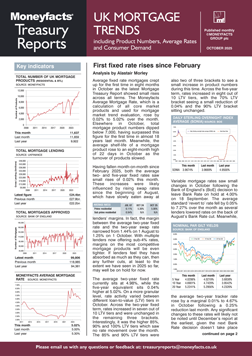Rachel Springall, Finance Expert at Moneyfacts, said:
“Borrowers with a limited deposit of just 5% or 10% will be thrilled to see the cost of a two-year fixed mortgage dip to a three-year low, before the ‘mini-Budget’ in September 2022. The number of deals available to borrowers at 95% loan-to-value has also improved, with the pool of deals at its highest count since 2008. The Government has been very vocal that it expects lenders to do more to boost UK growth, so the rise in choice and drop in cost is a healthy step in the right direction. However, deals at 95% loan-to-value only represent 7% of the residential mortgage market, so there is more room for improvement. Despite these moves, there will be borrowers who feel stuck due to a lack of supply in affordable housing.
“It may be a relief for borrowers to see fixed mortgage rates moving downwards once more. The Moneyfacts Average Mortgage Rate dipped below 5% and the activity among lenders led to a drop in the average shelf-life of a deal to 21 days. These movements will be positive news to those refinancing. Indeed, in November 2023, the average two-year fixed mortgage rate was 6.29%, compared to 4.94% now. That is a difference of £203 per month in repayments on a £250,000 mortgage over 25 years. There will also be millions of borrowers who secured a cheap five-year fixed rate back in 2020, who are due to refinance, so they do need to prepare themselves for higher mortgage repayments. Seeking advice to assess the latest deals and not to fall onto the revert rate is essential, particularly as the average SVR is 7.27%. It is worth noting that lenders are already working hard to price down their mortgages to entice new business as part of their end of year targets, supported by recent falls in swap rates. In addition, even existing borrowers can choose to lock into a new rate around six months before their current deal ends in most cases.
“The key date that is causing borrowers to adopt a ‘wait and see’ approach is without doubt the upcoming Budget. So far, the rumour mill has spun out a variety of ideas which could impact borrowers from different ends of the market. On one hand, the idea to abolish Stamp Duty Land Tax (SDLT) and an introduction of a new way of taxing could work in favour of first-time buyers, saving them thousands of pounds upfront, helping them get that crucial first step on the property ladder. However, like a double-edged sword, creating a new property tax that puts the burden on sellers could lead to homeowners refusing to move, hitting supply. Supply could worsen if CGT exemptions on primary residences is removed and if the yearly tax levy dubbed the ‘mansion tax’ becomes a reality. It is essential borrowers seek advice before they make any quick decisions and not feel rushed because of the Budget rumour mill.”
Rachel Springall, Finance Expert at Moneyfacts, said:
“Borrowers with a limited deposit of just 5% or 10% will be thrilled to see the cost of a two-year fixed mortgage dip to a three-year low, before the ‘mini-Budget’ in September 2022. The number of deals available to borrowers at 95% loan-to-value has also improved, with the pool of deals at its highest count since 2008. The Government has been very vocal that it expects lenders to do more to boost UK growth, so the rise in choice and drop in cost is a healthy step in the right direction. However, deals at 95% loan-to-value only represent 7% of the residential mortgage market, so there is more room for improvement. Despite these moves, there will be borrowers who feel stuck due to a lack of supply in affordable housing.
“It may be a relief for borrowers to see fixed mortgage rates moving downwards once more. The Moneyfacts Average Mortgage Rate dipped below 5% and the activity among lenders led to a drop in the average shelf-life of a deal to 21 days. These movements will be positive news to those refinancing. Indeed, in November 2023, the average two-year fixed mortgage rate was 6.29%, compared to 4.94% now. That is a difference of £203 per month in repayments on a £250,000 mortgage over 25 years. There will also be millions of borrowers who secured a cheap five-year fixed rate back in 2020, who are due to refinance, so they do need to prepare themselves for higher mortgage repayments. Seeking advice to assess the latest deals and not to fall onto the revert rate is essential, particularly as the average SVR is 7.27%. It is worth noting that lenders are already working hard to price down their mortgages to entice new business as part of their end of year targets, supported by recent falls in swap rates. In addition, even existing borrowers can choose to lock into a new rate around six months before their current deal ends in most cases.
“The key date that is causing borrowers to adopt a ‘wait and see’ approach is without doubt the upcoming Budget. So far, the rumour mill has spun out a variety of ideas which could impact borrowers from different ends of the market. On one hand, the idea to abolish Stamp Duty Land Tax (SDLT) and an introduction of a new way of taxing could work in favour of first-time buyers, saving them thousands of pounds upfront, helping them get that crucial first step on the property ladder. However, like a double-edged sword, creating a new property tax that puts the burden on sellers could lead to homeowners refusing to move, hitting supply. Supply could worsen if CGT exemptions on primary residences is removed and if the yearly tax levy dubbed the ‘mansion tax’ becomes a reality. It is essential borrowers seek advice before they make any quick decisions and not feel rushed because of the Budget rumour mill.”









